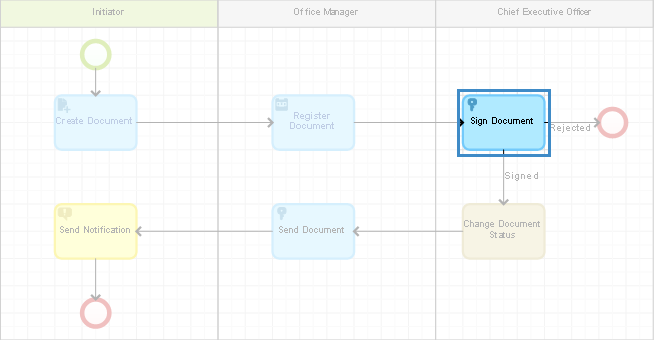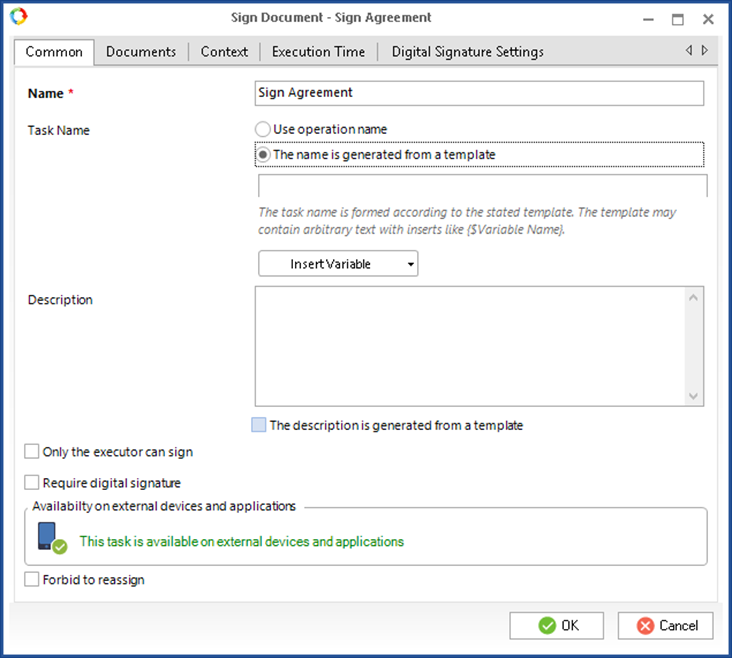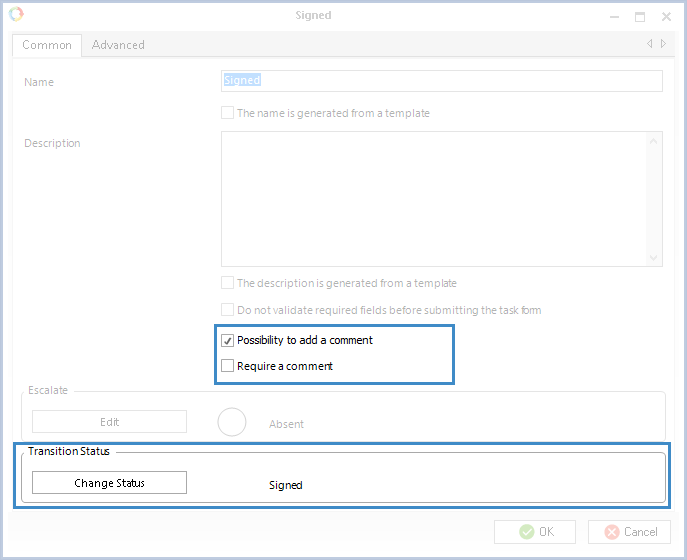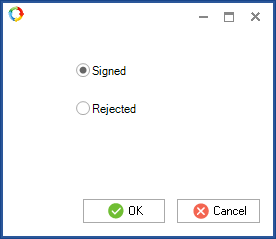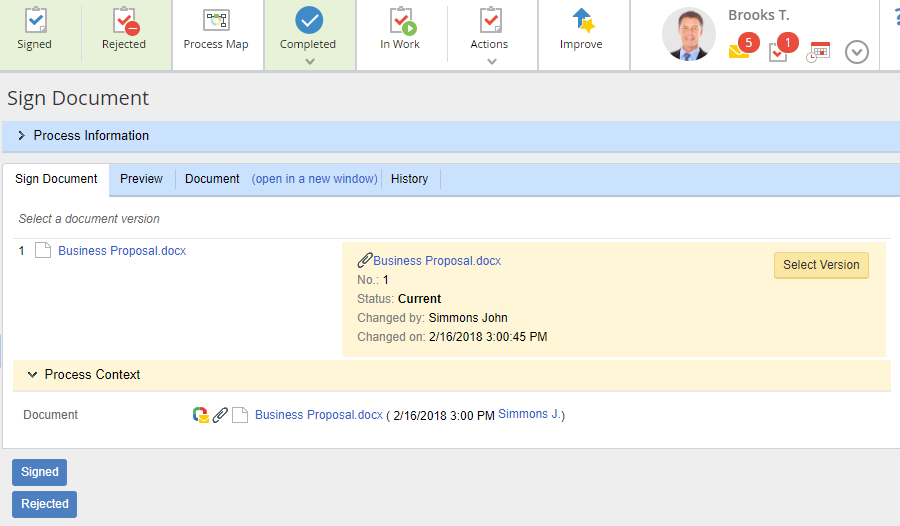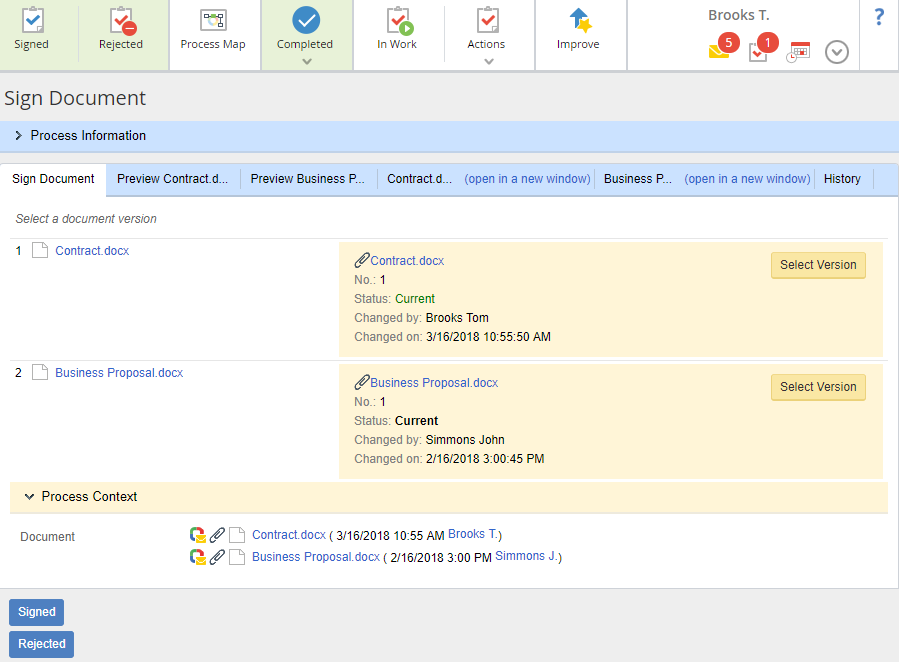This activity creates a form for signing a document in Web Application. Executors of this task are defined by the swimlane, in which this activity is.
You can place this activity only in a static or dynamic swimlane.
Settings of the Sign Document activity
To configure this activity, double click on it on the process graphic model (fig. 1). The page of this activity will open, which consists of the following tabs.
|
|
|
Fig. 1. Sign Document activity
|
Common tab
Fig. 2 shows an example of this tab.
Task Name – select an option of generating the name of the make decision task, displayed in Web Application.
-
Use operation name – use the name of the activity as the name of the user task;
-
The name is generated from template - generate the name from template. The template can include text, context variables and parameters of the current process instance.
Document Type – select the type of the created document.
Description – add a description of the activity.
Availability on external devices - this unit displays information on availability of this activity ELMA mobile application.
Only the executor can sign – if you check this box, only the task executor will be able to sign the document.
Require Digital Signature – this parameter allows signing documents only with digital signature.
Availability on external devices - this unit displays information on availability of this activity ELMA mobile application.
The Forbid to reassign option allows the user to reassign the task to other users in the Web Application. The administrator can preset this option Administration – Access settings – Processes, where access permissions can be assigned for each process. If the user does not have permissions to reassign tasks, then the Forbid to reassign option will be unavailable.
The Forbid to reassign to the substitute user options becomes available once the Forbid to reassign is selected. This option allows ignoring the substitutions settings made by the administrator. For example, if the executor is currently substituted by another user, the substitution settings will be ignored and the task will not be assigned to the substitute user.
Documents tab
Context tab
Digital Signature Settings tab
Configuring outgoing transitions from this activity
A Sign Document activity has to have to outgoing transitions with the Signed and Rejected statuses.
Configuring an outgoing transition from the Sign Document activity is similar to configuring a regular transition, but the first one has the Transition Status parameter and Possibility to add comments and Require a comment options (fig. 3).
|
|
|
Fig. 3. Transition Status parameter
|
Possibility to add a comment – if you check this box, the user will be able to add a comment when completing the task with this transition. When this box is checked, an additional field Require a comment is displayed.
Require a comment – if you select this checkbox, a user in the web application will have to leave a comment once the task is completed.
When you click Change Status, a dialog box opens, where you have to select the transition status (fig. 4).
|
|
|
Fig. 4. Selecting a transition status
|
Signed – the process will follow this transition, if the document is signed by the executor.
Rejected - the process will follow this transition, if the document is not signed by the executor
Sign document task in Web Application
Fig. 5 shows an example of a sign document task.
|
|
|
Fig. 5. Sign document form in Web Application
|
When signing a document package, the task form looks like this (fig. 6).
|
|
|
Fig. 6. Sign document package form in Web Application
|
This task is similar to a process task. However, it has some specific features.
Sign Document tab
|
|
|
Fig. 7. Selecting a document version
|
Preview tab
History tab
Document tab
On this tab you can view the document page. To edit the document page, click on Open in a new window.
Signed – when you click this button, the process will follow the Signed transition.
Rejected – when you click this button, the process will follow the Rejected transition.
Signing a document with a digital signature for the second time
In this case, a file’s contents (its version) can be signed by each user only once. If you try to sign it for the second time, you will see the following notification: Version with ID number cannot be signed for the second time since it has already been signed with a digital signature.
A document cannot be signed for the second time if:
-
a document must be signed with a digital signature;
-
a signed document undergoes the second approval as part of a business process;
-
after the first signing the document version was not changed.
Please note that a document can be signed for the second time neither with
Internal encryption provider, nor with
CryptoPro CSP.
Copyright © 2006–2019 ELMA

